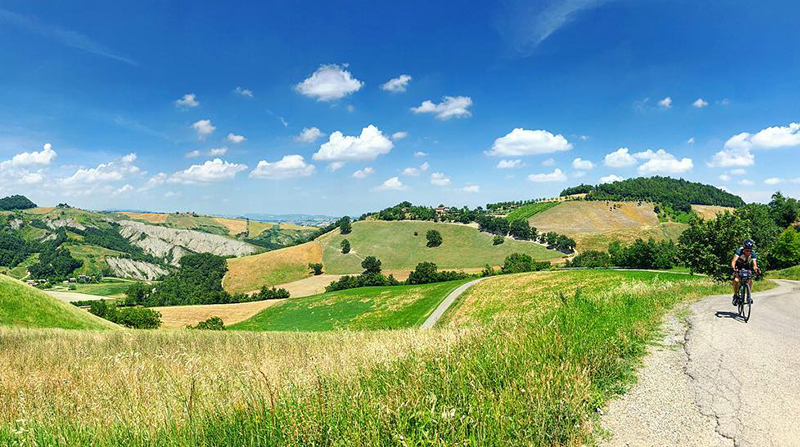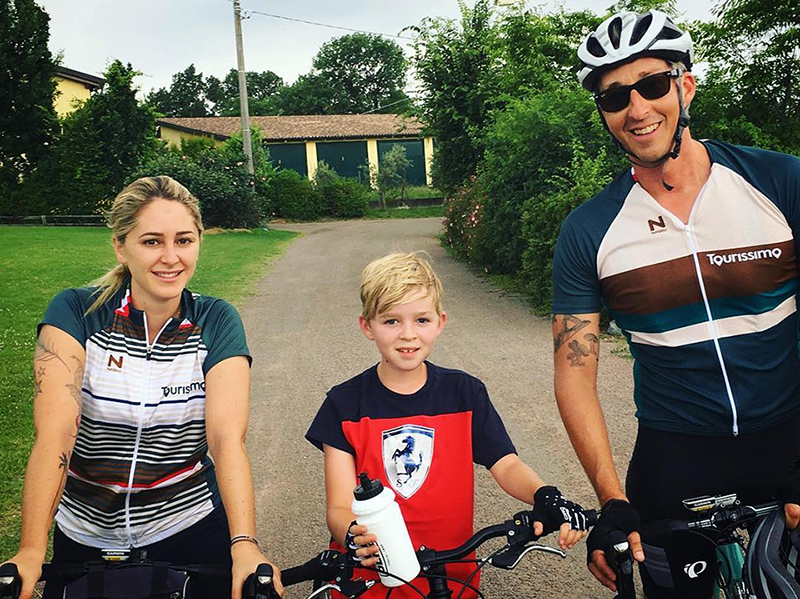

Riding Through Italy’s Emilia-Romagna Region. Credit: Brooke Williamson
When Top Chef season 14 winner Brooke Williamson got the chance to help lead a six-day, food-focused bike tour through the countryside of northern Italy’s Emilia-Romagna, she didn’t wait to grab her helmet and put her feet to the pedals.
“It’s a region that is known so well for its food, but maybe not recognized as a destination in Italy as much as other areas,” Williamson said. “I thought it was the optimal way to experience a food region.”
The trip wasn’t a ride in the park, though. While the fit chef is an avid SoulCyclist, the 200-mile journey through some steep, hilly terrain was demanding. The group had to be at breakfast by 7, on the bikes by 8 and prepared to log up to 55 miles a day.
But the grueling cycling paid off. “We got to see every inch of every town,” she said. “We really got to eat our way through the country without feeling the guilt because we spent the first half of the day biking. It really felt like you had accomplished something every single day.”
She turned it into a family trip, with her husband/co-chef Nick Roberts (the pair owns Company For Dinner restaurant group) and 10-year-old son Hudson pedaling alongside her during Tourissmo’s Chef Bike Tour.
Williamson gave us the scoop on her eating and biking adventure.

Brooke, Hudson and Nick. Credit: Brooke Williamson
Take us through the highlights of your gastronomic tour.
On day 1, they took us to a castle that we were staying in [Hotel Antico Borgo di Tabiano Castello’s]. We had dinner there with a sparkling malvasia from the property. It was really a beautiful first evening.
Then we rode to Parma the next day and had an incredible lunch of gnocco fritto [fried dough pillows]. Everywhere we went, we had the specialty of the town.
I don’t know that people realize how specific these towns are with what they are known for. Parma is known for Parma prosciutto, but the town next door, it’s culatello di Zibello, which is a completely different cured ham. And if you mix the two up, it’s insulting.
We stopped at the Alma Cooking School in the Ducal Palace of Colorno, where we all took a class. Nick and I took the reins on one of the dishes, and we all got diplomas from one of the biggest cooking schools in the world.
We went to Reggio and stopped at [Fattoria Rossi], a Parmesan factory, which was super cool. We got to know the Parmesan makers. It’s one family that passed it down generationally.

Biting Through Bologna. Credit: Brooke Williamson
We had lunch at Marta in Cucina in Reggio. This restaurant is one of those newer styles of cuisine, and it was interesting to hear the chef, Marta Scalabrini, and her take on people’s perception of her. A lot of people frown upon what she does because it’s not traditional, but the food was phenomenal.
When we got to Modena, we stayed in [Hotel Opera 02], which makes their own balsamic vinegar. When you walk into the lobby, it smells like balsamic vinegar because the aging room is a door on the right.
We went to Porretta Terme, a town that’s very well-known for its food, and stayed in [Hotel Helvetia], a thermal hot springs hotel.
At the end of it, my husband, son and I spent three days in Venice to be tourists, which was a cool way to unwind.
Among the dishes you tried, what were the ones that excited you the most?
The simplest items were the most impressive to me. Slivers of perfectly aged Parmesan cheese with a little bit of balsamic or honey over it. Of course, in Bologna, tortellini en brodo was like heaven on earth — just broth with tortellini. My son ate tagliatelle Bolognese almost every single meal for the entire week.
There weren’t specific dishes that blew my mind — it was the attention to individualized detail and how they could showcase the terroir of the specific town.
Why is one town known for this cheese and the town over known for a different cheese? It’s because of the cows that were there. It’s so hyper local.

Tortellini En Brodo. Credit: Brooke Williamson
What were some pleasant culinary surprises you tasted along the way?
I learned about nocino, which is from the green unripe walnut. It’s a walnut liqueur. Made with sugar, grain alcohol and the green walnut, it turns into a thick, sweet after-dinner drink.
We went into a whole thing after one dinner on where nocino came from and the fact that the walnut needs to be picked on the summer solstice before the sun rises by virgin girls — I don’t know how much the tradition is upheld these days but it’s very widely known that that’s how nocino is made. The guy who was telling the story from that region looked at me very seriously and said, ‘This is how it’s done. This is what we do.’ It was really fascinating.
I was blown away by dry sparkling malvasia. It’s now my most favorite sparkling wine, and it’s not very often found in the U.S. It was really stunning, and something I’m always in search of now.

The Gang at Fattoria Rossi Parmesan Factory. Credit: Brooke Williamson
Did this trip convince you that Emilia-Romagna is the best food region in Italy?
One hundred percent. Like I said, we went to Venice at the end of the trip, and as beautiful and charming as Venice is, no meal that we had held a candle to that Parmesan, that tortellini.
Would you visit Emilia-Romagna again?
This form of travel was something that I had never done. It was slightly exhausting — getting up every morning really early, having your bag packed, checking into a new hotel, but I honestly feel like really I understood where we were so much more than I ever have in any other country that I’ve been to — and I’ve traveled a lot.
I really feel like I’ve seen Emilia-Romagna now. I want to go back to Italy to see different things.
